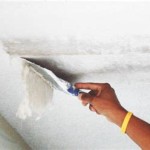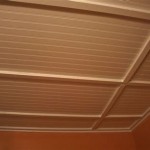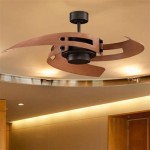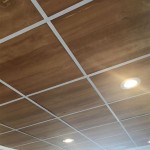Can You Paint Over Ceiling Tiles? A Comprehensive Guide
The question of whether ceiling tiles can be painted is a common one, particularly in buildings seeking a facelift without the extensive labor and cost of complete replacement. The short answer is yes, ceiling tiles can generally be painted. However, the process is not without its nuances, and careful consideration must be given to the type of tile, the existing condition, and the potential impact of the paint itself. In this article, we will explore the factors that determine the success of painting ceiling tiles and provide a detailed guide to achieving a satisfactory result.
Ceiling tiles offer several advantages. They are often used for acoustic dampening, providing a reduction in noise levels within a space. They can also conceal unsightly ductwork, wiring, and other mechanical systems. Over time, these tiles can become stained, faded, or otherwise visually unappealing, leading building owners and managers to explore cost-effective alternatives to replacement.
Painting ceiling tiles presents a viable avenue for aesthetic improvement, but it is important to understand that not all ceiling tiles are created equal. The material composition of the tile significantly impacts its suitability for painting. Furthermore, the existing condition of the tile, including any existing stains, damage, or pre-existing coatings, will influence the outcome.
Identifying the Type of Ceiling Tile
Before embarking on a painting project, the foremost step is to identify the type of ceiling tile installed. The most common types include mineral fiber tiles, fiberglass tiles, and gypsum tiles, each with distinct properties that affect paint adhesion and performance. Mineral fiber tiles, also known as acoustic tiles, are highly porous and absorbent. These tiles are often found in offices, schools, and commercial spaces where sound absorption is a priority. Fiberglass tiles, similarly used for acoustic purposes, tend to be more rigid and less porous than mineral fiber tiles. Gypsum tiles, also referred to as ceiling panels or drywall tiles, offer a smoother surface and can be more easily painted, provided they are properly prepared.
The material composition dictates the type of paint best suited for the tile. For porous materials like mineral fiber tiles, a thin, even coat of paint is crucial to prevent excessive absorption and potential sagging. For non-porous or less porous materials like fiberglass tiles, proper surface preparation is essential to ensure adequate paint adhesion. Improperly identifying the tile type can lead to paint failure, resulting in peeling, flaking, or an unsightly finish.
To determine the type of ceiling tile, a visual inspection can often provide clues. Mineral fiber tiles typically have a visible porous surface, sometimes exhibiting a texture akin to compressed paper. Fiberglass tiles usually have a smooth, felt-like surface. Gypsum tiles will appear similar to drywall, with a smooth, paintable surface. If visual identification is inconclusive, consulting the building's original construction documents or contacting the tile manufacturer can help determine the material composition.
Preparing the Ceiling Tiles for Painting
Proper preparation is paramount for achieving a professional and long-lasting paint job on ceiling tiles. This process involves cleaning the tiles, addressing any existing damage, and applying a suitable primer. Neglecting any of these steps can lead to unsatisfactory results and necessitate rework.
The first step in preparation is cleaning the ceiling tiles. Over time, dust, dirt, and airborne contaminants accumulate on the tile surface, hindering paint adhesion. A gentle cleaning with a soft brush or vacuum cleaner attachment is usually sufficient to remove loose debris. Avoid using excessive moisture, as it can damage porous tiles. For tiles with stubborn stains, a mild detergent solution can be used, but it’s crucial to test the solution on an inconspicuous area first to ensure it doesn't damage the tile.
After cleaning, inspect the tiles for any damage such as cracks, chips, or sagging. Minor imperfections can sometimes be repaired with patching compound specifically designed for ceiling tiles. However, severely damaged tiles may require replacement. Attempting to paint over extensive damage will likely result in an uneven and unsightly finish.
Once the tiles are clean and repaired, applying a primer is essential, particularly for porous tiles. Primer seals the surface, prevents excessive paint absorption, and promotes better adhesion. Select a primer specifically designed for use on ceiling tiles and apply it in a thin, even coat. Allow the primer to dry completely before proceeding with the paint application. The correct primer choice significantly contributes to the longevity and appearance of the finished project.
Selecting the Right Paint and Application Technique
The choice of paint and application technique is critical to the outcome of painting ceiling tiles. Not all paints are suitable for this purpose, and using the wrong type of paint can lead to problems such as sagging, peeling, or a reduction in sound absorption.
For most ceiling tiles, a latex-based paint with a flat or matte finish is recommended. Flat or matte finishes minimize light reflection, which helps to conceal imperfections and create a uniform appearance. Avoid using paints with a gloss or semi-gloss finish, as they can highlight any surface irregularities and reduce the tile's acoustic properties. It’s crucial to select a high-quality paint that is specifically formulated for use on ceilings, as these paints tend to be less prone to spattering and provide better coverage.
The application technique is equally important. Applying too much paint can saturate the tile, leading to sagging or warping, especially in porous tiles. A thin, even coat is always preferable. It is generally recommended to apply two thin coats of paint rather than one thick coat. This allows the paint to dry properly and provides better coverage without overloading the tile.
The recommended application method is spraying. Using an airless sprayer provides a consistent and even coat of paint without applying excessive pressure. When spraying, hold the nozzle approximately 12-18 inches from the tile surface and use smooth, overlapping strokes. If spraying is not feasible, a low-nap roller can be used, but caution must be exercised to avoid applying too much pressure. A small foam roller can also be useful for achieving a smooth finish.
Regardless of the application method, maintain a consistent pressure and speed to ensure a uniform coating. After applying the first coat, allow it to dry completely before applying the second coat. This allows the paint to properly adhere to the surface and minimizes the risk of sagging or other issues.
Consider the impact of painting on the tile's acoustic properties. Mineral fiber and fiberglass ceiling tiles are designed to absorb sound, and painting them can potentially reduce their effectiveness. Applying multiple coats of paint, or using a thick, heavy paint, can clog the pores of the tile and diminish its sound absorption capabilities. Choosing a thin, low-solids paint and applying it sparingly can help minimize this impact. In some cases, specialized acoustic paints are available, which are formulated to provide a decorative finish without significantly affecting the tile's sound-dampening properties.
Finally, safety precautions should always be observed when painting. Ensure adequate ventilation in the work area, wear appropriate personal protective equipment such as a respirator and eye protection, and follow the manufacturer's instructions for the paint and any cleaning or preparation products used. Taking these precautions can help ensure a safe and successful painting project.

Can You Paint Ceiling Tiles Hometalk

Ceiling Tile Paint Ideas How You Can Make Your Really Stand Out Decorative Tiles Inc

How To Paint A Drop Ceiling The Painting Company

How To Paint A Drop Ceiling The Painting Company

Ceiling Tile Paint Ideas How You Can Make Your Really Stand Out Decorative Tiles Inc

Ceiling Tile Paint Ideas How You Can Make Your Really Stand Out Decorative Tiles Inc

How To Make A Drop Ceiling Look Better

How To Paint Old Ceiling Tiles Hunker

Transform Your Nyc Ceiling With Pristine Painters Skim Coating

How To Make A Drop Ceiling Look Better
Related Posts








